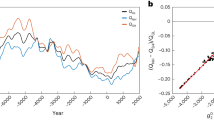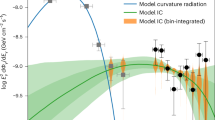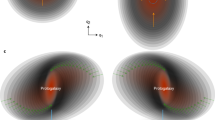Abstract
IT has been demonstrated1,2, using data from high counting rate instruments, that the daily variation of secondary cosmic ray intensity measured on the ground can in general be related on each day to an anisotropy of primary galactic cosmic rays. The anisotropy can vary from day to day in magnitude, in the directions with respect to the Earth–Sun line of maximum intensity Tmax and of minimum intensity Tmin outside the influence of the geomagnetic field, and in the energy spectrum of variation. Tmax and Tmin are usually separated by 8–10 h. This has led Rao and Sarabhai to suggest that the anisotropy appears generally to be due to two principal processes, one a modulation equivalent to a pair of oppositely directed positive and negative sources, and the other a negative virtual source approximately oriented along the garden hose direction towards the Sun.
This is a preview of subscription content, access via your institution
Access options
Subscribe to this journal
Receive 51 print issues and online access
$199.00 per year
only $3.90 per issue
Buy this article
- Purchase on SpringerLink
- Instant access to full article PDF
Prices may be subject to local taxes which are calculated during checkout
Similar content being viewed by others
References
Rao, U. R., and Sarabhai, V., Planetary and Space Sci., 12, 1055 (1964).
Sarabhai, V., and Subramanian, G., Proc. Intern. Cosmic Ray Conf., Jaipur, 2, 307 (1963).
Ness, N. F., and Wilcox, J. M., Phys. Rev. Letters., 13, 461 (1964).
Parker, E. N., Planetary and Space Sci., 12, 735 (1964).
Sarabhai, V., Geophys. Res., 68, 1955 (1963); Proc. Intern. Cosmic Ray Conf., Jaipur, 2, 117 (1963).
Parker, E. N., Astrophys. J., 133, 1014 (1961).
Bridge, H., Egidi, A., Lazarus, A., Lyon, E., and Jacobson, L. (personal communication).
McCracken, K. G., and Parsons, K. R., Phys. Rev., 112, 1798 (1958).
Lockwood, G. A., and Razdan, H., J. Geophys. Res., 68, 1581 (1963).
Author information
Authors and Affiliations
Rights and permissions
About this article
Cite this article
SARABHAI, V., PAI, G. & WADA, M. Anisotropy of Galactic Cosmic Rays and the Interplanetary Magnetic Field. Nature 206, 703–704 (1965). https://doi.org/10.1038/206703a0
Published:
Issue date:
DOI: https://doi.org/10.1038/206703a0
This article is cited by
-
Some effects of the solar wind
Il Nuovo Cimento B Series 10 (1970)
-
Daily variation of cosmic-ray intensity during active and quiet periods of solar activity
Il Nuovo Cimento B Series 10 (1966)
-
Daily Variation of Cosmic Rays
Nature (1965)



